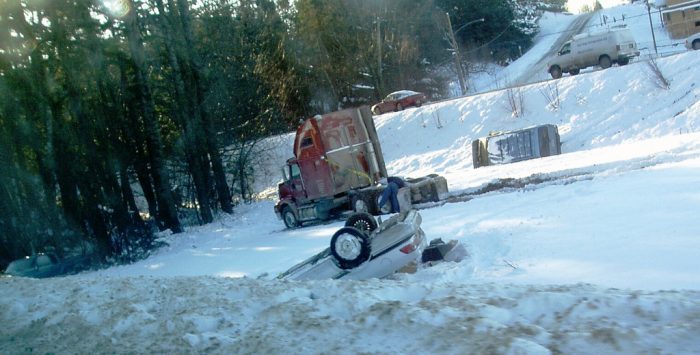Bad weather driving
If You’re Driving on Snowy or Icy Roads:
If you’re going to be driving in bad weather this year, be sure to check out these tips!
- Slow down. Even if you have all-wheel drive, reduce your speed about 10 miles per hour below the speed limit. If it still feels iffy, cut back another five miles per hour until you’re comfortable.
- Beware of black ice. It’s nearly impossible to see this crystal-clear glaze, but you can spot it when your headlights reflect off the road at night. It tends to form on bridges, which trap the cold; in the shadows of tall buildings, where the sun can’t hit it; and at intersections, due to drains. That’s why, in bad weather, you should slow down a couple of hundred feet before stop signs and lights.
- Avoid tailgating. On the highway, leave about 100 yards (about the length of a football field) between you and the car ahead of you to give you plenty of room to stop in case that person brakes suddenly. Still, it’s close enough to use his headlights to see what’s up ahead.
- Don’t brake during a turn. To avoid a spin-out, gradually start turning the steering wheel and feathering the brakes lightly before the curve. Then coast through the turn with your foot off the brake and off the gas, so as not to gain speed. When you have your foot on the brake, the wheels stop turning. That’s when the car loses control and goes in any direction that momentum decides to take it, like a toboggan.
- Turn into a skid. Remain calm, take your foot off the brake and the gas pedals, and turn the car in the direction the car is skidding. For example, if you’re sliding to the left, gently turn the steering wheel to the left. This cancels out the skid. The car corrects itself and goes straight. If all else fails and you have the option to do so safely, leave the road and drive the car into a snow bank.
-
If You’re Driving in Foggy Conditions:
- Turn on the fog lights. (There’s usually a switch on the dashboard or on the same lever that controls the turn signal, but you can also use low beams in a pinch.) The lights are yellow, which cuts through fog better than white lamps do, and they’re low to the ground so the beams illuminate the road well.
- Pump the brakes before entering a fog bank. This alerts the cars trailing you to back off. If you wait to apply the brakes until you’re in the thick of it, you could get hit from behind.
- Slow down before a hill. Be extra-cautious driving over the crest of a hill because you won’t be able to see if there’s another car stopped there.
If You’re Driving in Rainy Weather:
- Slow down by at least 5 or 10 miles an hour. At certain speeds, your car can hydroplane, lifting off the ground, and you will be driving on a layer of water. If that happens, don’t panic; just slow down until the car feels normal again.
- Avoid driving through flooded areas. It will be difficult to gauge the water’s depth. This is dangerous in itself. And if water gets sucked into the air-intake valve and then the engine, the car will probably shut off.
- Feather the brakes after you’ve driven through a puddle. And make sure you take your foot off the gas. This creates heat and friction, which will help dry the brakes.
If You’re Having Car Trouble:
- Make sure your car is out of the way of traffic. Pull off the road and put on your hazard lights. Set out flares around your car so it will be clearly visible to other vehicles. Place three at 100, 50, and 25 feet behind the vehicle. Be careful that they aren’t too close to any combustible grass or vegetation.
- Don’t wander off. It’s easy to lose direction in a storm. Stay with your car until help arrives.
- Use the floor mats in a pinch. If your tires are stuck in the snow, you can use cat litter, sand, or the car’s floor mats under tires to help gain traction. It’s a good idea to also stow a shovel in trunk so you can dig out the wheels. If the car is buried in snow, it’s crucial to first make sure that the exhaust pipe is exposed. If the pipe is blocked by snow, it can send dangerous carbon monoxide into your car.
Prep your car for bad weather.
- Inspect windshield wipers. Replace any that have cracked rubber. If your area gets a lot of snow and ice, invest in winter blades, which shed ice better.
- Clean headlight covers. When they sit in the sun, they eventually turn yellow and cloudy, and that cuts the amount of light coming from your headlights. (Try Rain-X headlight-restoration kit; $16, advanceautoparts.com.)
- Check tire treads. Try this classic Real Simple trick: Insert a penny into the tires’ grooves in several spots. Make sure to slip the coin into the tread so that Abraham Lincoln goes in headfirst. If you can see the top of the president’s head, the tires are worn down too much and should be replaced. And if the place you live gets a lot of extreme weather, consider buying winter tires. “All-season tires” is a misnomer. These tires are made of a dense compound that turns hard as a rock in the cold and won’t stand up to slippery streets. Winter tires are made from a softer compound, which stays pliable and sticks to the road better.
- Get your car winter-serviced. This is important if you live in a cold-weather area. It includes adding winter-grade fluids that resist freezing, like antifreeze, oil, and windshield-wiper solution. Also make sure that the levels are topped off throughout the season.
- Stock an emergency kit. Include road flares, a blanket, a shovel, a flashlight, jumper cables, a tow rope, an air compressor, duct tape, and an ice scraper. You may also want to add dry food, water, toilet paper, and warm clothes.
-
See what LiteTrax can do for you

